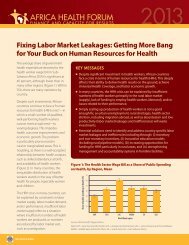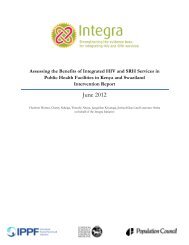ujh78
ujh78
ujh78
You also want an ePaper? Increase the reach of your titles
YUMPU automatically turns print PDFs into web optimized ePapers that Google loves.
percentage points. Senegal showed a major decrease in the percentage of children living more than a 15<br />
minute walk from the primary water source (28 percentage point decrease).<br />
Lack of access to any sanitation facilities whatsoever in or near their homes. Overall, there<br />
were no sex disparities related to children’s access to sanitation facilities. In all of the sub-Saharan<br />
African countries, the percentage of children who did not have access to any sanitation facilities was<br />
higher in rural areas than in urban areas. In Benin, Burkina Faso, Ghana, and Senegal, the percentage of<br />
children without access to any sanitation services was more than 11 percentage points higher for children<br />
living with a male household head than for children living with a female household head. Ethiopia<br />
experienced the largest reduction (23 percentage points) in the percentage of children who do not have<br />
access to any sanitation facilities. Other countries that experienced reductions of more than five<br />
percentage points included Burkina Faso, Lesotho, Malawi, and Mozambique. Only Nigeria, with a 6<br />
percentage point increase, and Tanzania, with a 2 percentage point increase, experienced increases in the<br />
percentage of children who did not have access to any sanitation facilities.<br />
7.4 Shelter Deprivation<br />
Living in houses with mud floors. Overall, there were no sex disparities related to living in a<br />
house with a mud floor. However, we found large rural-urban differences. In every country a higher<br />
percentage of children lived in houses with mud floors in rural areas than in urban areas. In two-thirds of<br />
these countries, the percentage living in houses with mud floors was higher for children living with a male<br />
rather than a female household head. This difference was about 15 percentage points in Burkina Faso,<br />
Guinea, Nigeria, and Senegal. The inverse situation occurred in Namibia, a 10 percentage point<br />
difference. The percentage living in houses with mud floors was much higher for children living with a<br />
household head at least 50 years old than for children living with a younger head of household in Namibia<br />
(28 percentage point higher), Lesotho (17 percentage points higher), and Zambia (11 percentage points<br />
higher). Three countries—Ghana (3 percentage points), Nigeria (4 percentage points), and Zambia (3<br />
percentage points)—experienced an increase on the percentage of children living in houses with mud<br />
floors. In the rest of countries explored in this study, the percentage of children living in houses with mud<br />
floors decreased.<br />
Living in houses without electricity. Overall, there were no sex disparities with regard to having<br />
electric power at home. In every country, however, the percentage of children living in houses without<br />
electricity was higher in rural areas than in urban areas. The sex of the household head mattered in<br />
Senegal, where the percentage living without electricity was 53% for children living with a male<br />
household head and 27% for children living with a female household head. In Namibia and Uganda the<br />
percentage without electricity was slightly higher (2 percentage points) among children living with a<br />
household head age 50 or older than for children living with a younger household head. In nearly all these<br />
countries, the percentage living in houses without electric power decreased. In Nigeria, however, the<br />
percentage of children living in houses without electricity increased by 4 percentage points. Madagascar<br />
experienced an increase of 2 percentage points.<br />
7.5 Education Deprivation<br />
Children who have received no primary or secondary education. Overall, there were<br />
inconsistent differences related to a child’s sex in the percentage ages 0 to 17 years without education. In<br />
some countries the percentage was higher for males; in others, for females. For instance, the greatest<br />
difference occurred in Niger, where 55% of males and 69% of females had no education, a difference of<br />
14 percentage points. The percentage of children without education was about 10 percentage points<br />
higher for females than males in Benin, Guinea, and Mali. The inverse situation, but less marked,<br />
occurred in Kenya and Lesotho, where a higher proportion of male children than female children had no<br />
139








